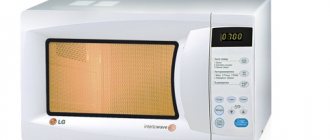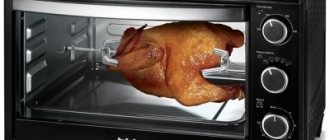Who invented the household microwave oven?
There are two versions of creating an electrical appliance. According to the first, the history of the microwave began during World War II: the technique was invented in Germany for the German military. Later, the drawings of the German microwave came to other countries, including the USSR.
According to the second version, the invention of the microwave oven belongs to the US scientist and engineer Percy LeBaron Spencer.
During one of his experiments, Spencer noticed the effect of magnetic waves on a candy lying in his pocket. After this, the scientist tried to perform a similar experiment, only with popcorn. The result was similar.
After conducting a series of experiments, Spencer registered his first patent on October 8, 1945. Two years later, microwaves went into production, but they were used only by the military to quickly defrost food.
Biography of Percy LeBaron Spencer
The future inventor was born in Maine on July 9, 1894. When Spencer was three years old, his father died and the boy was sent to be raised by his aunt.
At the age of 12, Spencer began working in a spinning mill, without even receiving a secondary education.
Percy Spencer in his youth
In 1925, Percy got a job at the newly emerging company Radarange, which was developing equipment for radars.
In 1945, he made the greatest discovery of his life - heating food under microwave radiation.
What dishes should you use in your microwave oven?
It is best if the microwave plate that you are going to use in the microwave oven is specialized, with appropriate markings. This includes, for example, sets of cookware made of heat-resistant glass. If you don’t have one at hand, then pay attention to the following recommendations:
- Glass. Excellent material for the microwave, as long as it is not too thin and there are no cracks or chips.
- Porcelain and faience. Suitable materials are provided that they are completely glazed and not painted with metallic paint. Again, porcelain or earthenware should not have mechanical damage.
- Paper. Suitable material, but with assumptions - the paper must be thick, not colored, and it is better not to use it for a long time.
- Plastic. Yes, but only specialized ones. Today, many companies produce entire lines of plastic containers for heating in microwave ovens. An ideal option for an office worker who does not want to splurge on business lunches and trips to cafes.
The most unsuitable plate for the microwave is a metal one. High-frequency radiation causes it to spark, which will soon send you looking for a place where microwave ovens are repaired.
The world's first microwave ovens
The first electrical devices from this series came into use only in 1947, but only the military had them. The first samples belong to the Radarange company.
The first microwave ovens from Radarange
The dimensions of the devices were impressive: about 1.8 meters wide and about two meters high. The mass of the first microwave ovens was approximately 300 kilograms, so several people were required to move the electrical appliance.
Most samples had a transparent window that allowed you to monitor the melting of food. To cool this giant, ordinary water was used, and it required a lot of electricity to operate. As a result, the cost was very high - each device cost about three thousand dollars.
Market Capture
Despite all the fears and publications, microwave ovens were actively produced and sold. The American inventor had no doubt about the effectiveness of his product, despite the indignation and criticism of scientists.
Here are a few stages that furnaces have gone through from their inception to the present day:
- The first ovens were incredibly bulky and reached a height of about 1.8 meters. The devices weighed approximately 1.5 tons, which did not allow the device to be moved without assistance. Their cost was approximately $1,000, which indicated that only very wealthy citizens could afford a microwave.
- The stoves went on sale in 1962.
- In 1966, the stoves began to be equipped with the usual rotating stand.
- By 1979, the furnace was already controlled by a microprocessor.
- And in 1999, control began to be carried out by a microcomputer. Such familiar functions as grill and convection appeared, and the oven itself began to be used not only for heating, but also for cooking.
It is interesting that, despite all the intimidation of the press and scientists, by 1975 the level of microwave sales exceeded the sale of gas stoves. And in 1976, the popularity of microwaves eclipsed dishwashers.
Scientists' disputes
After Spencer created the device, the scientists split into two groups. Some believed that the device was safe and people could use it without fear of health. Others argued that the electrical appliance could lead to the development of dangerous diseases such as cancer.
At the same time, no contraindications have been reported from the inventors of the stove. Opponents of microwave ovens argued that baby food and milk should not be heated in an oven due to the negative effects of microwave waves.
In addition, when water molecules are passed through microwaves, some of the radiation remains in the food. This can contribute to a decrease in hemoglobin in the blood and an increase in cholesterol.
Myths about the microwave oven
From the origins of microwave ovens to this day, there has been a lot of misinformation about the devices. Here are the most common:
- The molecular structure of foods after microwave ovens changes and they become dangerous. In fact, the movement of water molecules accelerates, and the food heats up as a result. All that can happen to food is local overheating, which will lead to burning or a decrease in nutrients in the food.
- Microwaved food may taste different, but no changes in molecular composition occur. The device simply heats the food equally on all sides, because of this the moisture is distributed evenly, unlike an oven or frying pan.
- The quality of heating in microwave ovens does not depend on the price of the device. This is evidenced by a number of experiments conducted with devices of different price categories. When purchasing an expensive microwave oven, the user pays for build quality, brand, and safety. After all, many unknown companies undergo incomplete testing or do not test their products at all.
- The microwave oven emits harmful rays. It is not true. As long as a safe distance of one and a half meters is maintained, a person is not in danger.
A little humor...
One lady in the US won a lawsuit after she “dried” her cat in the microwave. In the statement of claim, she indicated that she did not know that “you cannot dry cats in the microwave.”
Despite the well-known fact that raw chicken eggs explode in the microwave, enthusiasts around the world are trying to come up with a way to get around this problem - pierce a hole in the shell and wrap it in a special film. But despite all their efforts, the eggs still explode.
Recently, the Internet exploded with a fake message that the new iPhone model can be recharged from a microwave. It is unknown how many smartphone owners fell for this prank, but dozens of photos with damaged iPhones speak for themselves.
Distribution of microwave ovens
Despite the suspicions and fears of scientists, the equipment successfully gained sales momentum, because it was a convenient and practical thing in everyday life. The inventor himself had no doubt about the success of his product, as he considered it irreplaceable. Let's look at the stages of microwave development:
- The very first household microwaves were enormous in size. Initially, they were used only by the military, but by 1949 mass production began, and electrical appliances appeared in rich homes. The cost of the device was three thousand dollars.
- Microwave ovens were improving and by 1962 they were becoming much more affordable. The price for one device has decreased several times.
- In 1966, the rotating rack was invented to distribute the outgoing microwaves evenly onto the dish.
- By 1979, the electrical consumption of microwave ovens was reduced due to the installation of a microprocessor. Another useful feature is added - automatic shutdown.
Microwave ovens equipped with a microprocessor - Control of electrical appliances became even more simplified with the introduction of the microcomputer in 1999. At this time, functions also appeared that made it possible not only to heat up ready-made food, but also to cook it. This was facilitated by the “Grill” and “Convection” functions.
The first household microwave oven and the start of mass production
From the time the first microwave oven was invented, decades passed before its mass use. There were several reasons for this:
- High cost of equipment;
- Criticism of this gadget by scientists;
- As a consequence of the second point, there is negative PR for this device in the press.
Despite these obstacles, work to improve and optimize microwaves has been quite active. And already in 1962, it launched the first conveyor production of microwave ovens (by the way, the modern analogue of the oven of this company, SHARP R200WW, is very different from its predecessors).
Due to harsh criticism, the first production versions of the unit were not particularly popular, but time passed and microwave ovens nevertheless captured the market. In 1966, a rotating rack was developed to heat food evenly. From the time when the very first microwave oven was released until 1979, another transformation occurred: a microprocessor control system for the device appeared, which made it much easier to use. Such microwave ovens began to actively enter the family life of those times.
This is interesting: Top 10 manufacturers of microwave ovens
Microwave Oven Distribution Problems
Electrical appliances spread throughout the world very quickly due to the ability to cook delicious food in the shortest possible time. But the device was banned in the Soviet Union. The slogan was put forward: “Let’s protect our citizens!” All because of the research of Soviet scientists who came to the following conclusions:
- The process of decomposition of substances is accelerated due to exposure to microwaves.
- Cancerous growths appeared in food passed through microwaves. They arose due to the interaction of waves, water and modified proteins.
- Due to the incorrect structure of food consumed, metabolism changes.
- Cancer cells form in our blood.
- A field is formed around the microwave oven, which has a detrimental effect on the health of the person located in this field.
- Food cooked in a microwave oven can lead to disruption of human protective functions.
- Stomach dysfunction may occur.
Types of Microwave Ovens
What types of microwave ovens are there and how they differ from each other:
- Solo oven, or ordinary microwave. It is one of the most budget models and is intended only for defrosting and heating food. As a rule, such microwave ovens are mechanically controlled and are quite reliable, since there is nothing special to break.
- Microwave with grill and convection. These microwave functions can be used both together and separately. The grill consists of an additional heating element, which is most often located under the ceiling of the chamber, and a rotating spit. Convection is the circulation of hot air inside the chamber, which provides additional and more uniform heating of food. Such microwaves, as a rule, belong to the middle price category and operate with both mechanical and electronic controls.
- Multifunctional microwave ovens. Many modes, of course, convection and grill, a double boiler function, as well as a whole range of culinary solutions for your kitchen. Of course, such serious household appliances are classified as expensive and controlled using sophisticated electronics.
Despite the differences in details, a microwave oven for 20 dollars and one for 200 are still the same microwave. The operating principle is the same.











